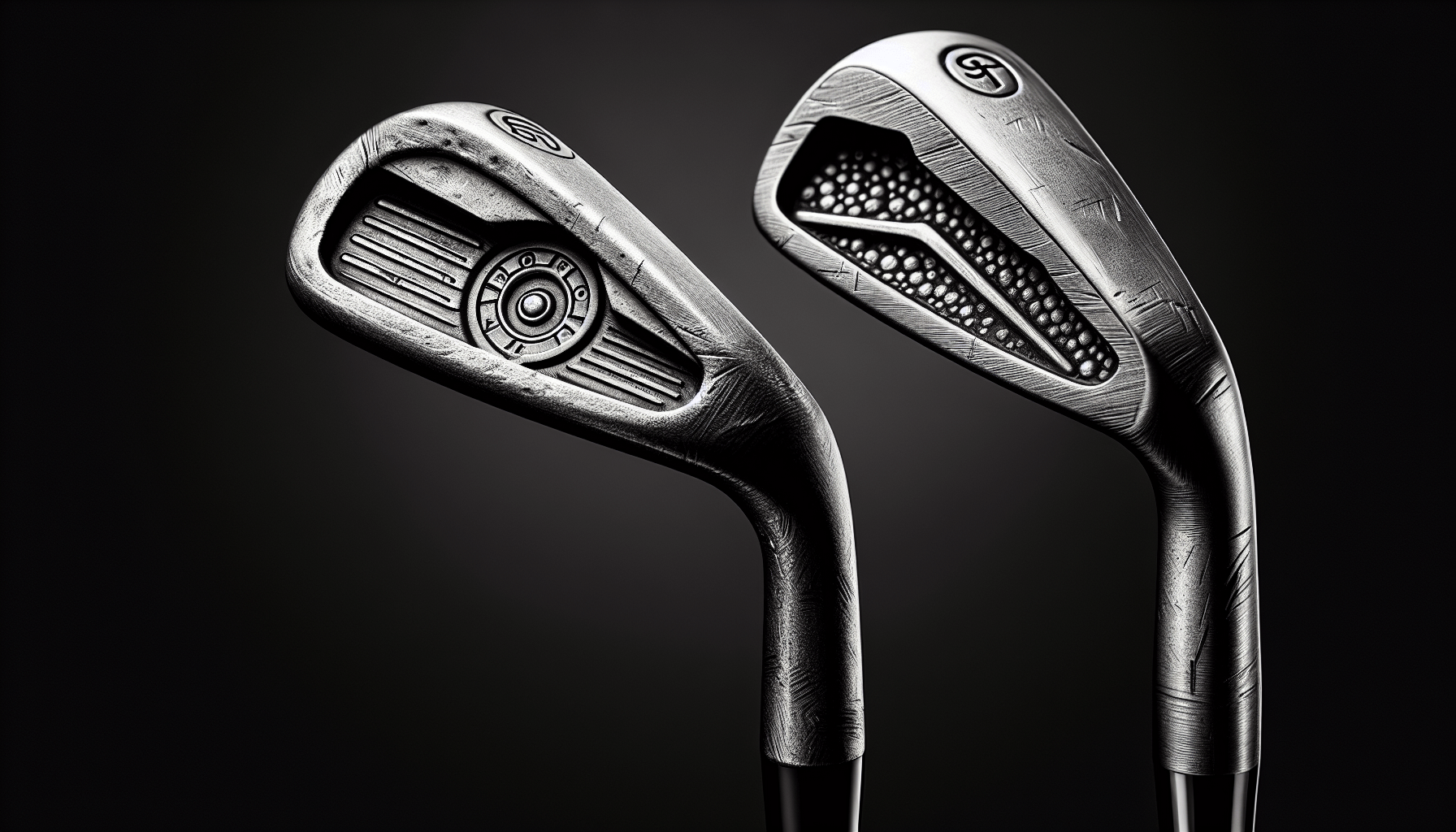Don't miss our holiday offer - up to 50% OFF!

Comparing Forged Vs. Cast Irons: Which Is Right For You?
Upgrade your golf clubs with this informative post comparing forged and cast irons. Understand the differences, benefits, and choose the right one for your game. Improve your golfing experience today!
Looking to upgrade your golf clubs? When it comes to irons, the decision between forged and cast can be a daunting one. Both options have their pros and cons, and it’s important to choose the right one for your game. In this article, we will compare forged and cast irons, discussing their differences, benefits, and which one might be the right choice for you. Whether you’re a seasoned player or just starting out, understanding the characteristics of these irons will help you make an informed decision and improve your golfing experience. So, let’s dive into the world of forged and cast irons and find out which one suits you best!
Understanding Irons: Forged vs Cast
When it comes to golf irons, there are two commonly used manufacturing methods: forging and casting. Both methods have their own unique characteristics and qualities, which can greatly impact your performance on the golf course. Understanding the differences between these two types of irons can help you make an informed decision when Choosing the right set for you.
Basic Definition of Forged Irons
Forging is a traditional manufacturing process that involves shaping the iron clubheads by compressing and shaping a solid piece of metal using extreme heat and pressure. This process creates a dense and tightly packed grain structure, resulting in a more solid and consistent clubhead. Forged irons are known for their excellent feel and feedback, making them a popular choice among skilled and experienced golfers.
Basic Definition of Cast Irons
On the other hand, casting is a more modern manufacturing process that involves pouring liquid metal into a pre-formed mold and allowing it to cool and solidify. This process allows for more complex and intricate clubhead designs, as well as greater flexibility in terms of clubhead weight distribution. Cast irons are generally more forgiving and offer a larger “sweet spot,” making them suitable for golfers of all skill levels.
Manufacturing Process
How Forged Irons are Produced
Forged irons are typically produced through a multi-step process. It begins with a raw block of steel, which is heated to extreme temperatures and then shaped using a special hammer or press. This compression process creates the desired shape and allows for precise control over the clubhead’s characteristics. The clubheads are then further refined through grinding, polishing, and heat treatment to enhance their strength and durability.
How Cast Irons are Produced
In contrast, cast irons are produced through a casting process. A mold is created with the desired clubhead shape, and molten metal is poured into the mold. As the metal cools and solidifies, the mold is removed, leaving behind the finished clubhead. This process allows for greater design flexibility and can accommodate more intricate clubhead shapes. Cast iron clubheads are typically finished through grinding, sanding, and polishing.
Material Characteristics
Material Constituents of Forged Irons
Forged irons are usually made from soft carbon steel or stainless steel. These materials offer excellent durability, strength, and responsiveness. The dense and tightly packed grain structure of forged iron clubheads enhances their overall performance and feel. The softer steel used in forging also allows for better shot-shaping capabilities and greater feedback, providing more control for skilled golfers.
Material Constituents of Cast Irons
Cast irons are typically made from stainless steel or a combination of materials, including steel, aluminum, and polymers. The choice of materials varies depending on the desired performance characteristics of the clubhead. Cast irons often have a cavity back design, which redistributes weight around the perimeter of the clubhead to increase forgiveness and improve off-center hits.
Durability and Robustness
Longevity and Wear Resistance of Forged Irons
Forged irons are known for their exceptional durability and wear resistance. The dense grain structure of the clubheads provides added strength, allowing them to withstand the rigors of repeated use. However, it is important to note that the softer steel used in forging may be more susceptible to scratches and dings compared to cast irons. Regular maintenance and care are essential to ensure the longevity and optimal performance of forged irons.
Longevity and Wear Resistance of Cast Irons
Cast irons also offer good durability and wear resistance, although they may not be as robust as forged irons. The use of various materials in the casting process can affect the overall strength and longevity of the clubheads. However, the cavity back design of cast irons helps distribute the weight more evenly, reducing the stress on specific areas of the clubhead and increasing their ability to withstand wear and tear over time.
Performance and Efficiency
Achieving Desired Outcomes with Forged Irons
Forged irons are favored by skilled golfers who prioritize control, feel, and shot shaping. The solid and consistent clubhead design allows for greater precision and control over ball trajectory and spin. The soft steel used in forging also provides better feedback to the golfer, allowing them to make adjustments and fine-tune their shots. Additionally, the compact design of forged irons enhances workability, making it easier to shape shots and control distances.
Achieving Desired Outcomes with Cast Irons
Cast irons, on the other hand, are known for their forgiveness and distance. The cavity back design and perimeter weighting improve stability and increase the Moment of Inertia (MOI), resulting in greater resistance to twisting upon impact. This forgiveness ensures that off-center hits still maintain decent distance and accuracy. Cast irons are particularly beneficial for golfers who are still developing their swing or those who prioritize a more forgiving clubhead design.
Variation in Price
Cost Evaluation of Forged Irons
Forged irons often come at a higher price point compared to cast irons due to the more intricate and time-consuming manufacturing process. The extensive labor and expertise involved in forging, as well as the use of high-quality materials, contribute to the higher cost. Golfers who value the premium feel, control, and workability of forged irons are generally willing to invest in a higher-priced set.
Cost Evaluation of Cast Irons
Cast irons, on the other hand, tend to be more affordable compared to forged irons. The casting process allows for mass production and greater cost efficiency. This makes cast irons a suitable option for budget-conscious golfers or those looking for a cost-effective choice without compromising on performance.
Suitability and Skill Level
When to Use Forged Irons Based on Skill Level
Forged irons are generally recommended for skilled and experienced golfers. The excellent feedback and workability provided by forged irons require a certain level of skill and control to fully utilize. Beginner or high handicap golfers may find it challenging to consistently strike the sweet spot and benefit from the shot-shaping capabilities of forged irons. However, intermediate golfers who are looking to improve their game and have better control over their shots may also consider transitioning to forged irons.
When to Use Cast Irons Based on Skill Level
Cast irons are suitable for golfers of all skill levels, from beginners to professionals. The forgiving nature of cast irons helps minimize the impact of off-center hits, allowing golfers to achieve greater distance and accuracy. Beginner golfers can benefit from the large sweet spot and increased forgiveness, while skilled golfers who prioritize forgiveness over shot-shaping capabilities may also choose cast irons.
Aesthetic Appeal
Visual Appeal and Finish of Forged Irons
Forged irons are often regarded as the more aesthetically pleasing option due to their clean and classic look. The forging process allows for greater attention to detail and craftsmanship, resulting in a sleek and refined appearance. Many golfers appreciate the timeless beauty of forged irons and find the minimalistic design appealing.
Visual Appeal and Finish of Cast Irons
Cast irons offer a wider range of design options and finishes due to the casting process. Manufacturers can incorporate more intricate patterns, logos, and color schemes into the clubheads. This variety allows golfers to choose a set of irons that not only performs well but also suits their personal style and preferences.
Maintenance and Care
Maintaining Forged Irons for Optimal Performance
To maintain the performance and longevity of forged irons, regular maintenance is crucial. It is recommended to clean the clubheads after every round using a soft cloth and mild detergent. Avoid using abrasive materials or harsh solvents that can damage the finish. Additionally, keep the clubheads dry and store them in a cool and dry place to prevent rust or corrosion. Periodic inspection and regripping are also essential to ensure optimal performance.
Maintaining Cast Irons for Optimal Performance
Caring for cast irons involves similar practices as those for forged irons. Regular cleaning with a soft cloth and mild detergent is necessary to remove dirt and debris. It is important to inspect the clubheads for any signs of wear or damage and address them promptly. Additionally, storing the clubs in a dry place and avoiding exposure to extreme temperatures or humidity can help maintain their performance and overall condition.
Popular Brands and Models
Top Forged Iron Brands and Models
Some of the top brands known for their forged irons include Titleist, Mizuno, Callaway, and TaylorMade. Titleist offers popular forged iron models like the Titleist AP2, known for its excellent feel and workability. Mizuno’s MP line, including the MP-20 and MP-18, are highly regarded by professionals and skilled golfers for their exceptional craftsmanship and performance. Callaway’s Apex and TaylorMade’s P7 series are also among the top choices for golfers seeking the precision and control of forged irons.
Top Cast Iron Brands and Models
Leading brands in the cast iron category include Ping, TaylorMade, Callaway, and Cobra. Ping’s G series, such as the G410 and G425, offer forgiveness and distance combined with sleek designs. TaylorMade’s SIM Max and M2 irons provide a balance of forgiveness and performance, making them popular among golfers of all skill levels. Callaway’s Big Bertha and Rogue models offer improved forgiveness and distance, while Cobra’s F-MAX series caters to golfers seeking maximum forgiveness and moderate swing speeds.
In conclusion, the choice between forged and cast irons ultimately boils down to personal preference, skill level, and desired performance characteristics. Forged irons are favored by skilled golfers who value control and shot shaping, while cast irons offer forgiveness and distance, making them suitable for golfers of all skill levels. Understanding the manufacturing processes, material characteristics, and other factors can help you make an informed decision and find the perfect set of irons to enhance your golfing experience.
